Effective Post-operative Nursing Strategies in Cardiac Surgery Care
VerifiedAdded on 2021/04/17
|11
|3012
|69
Report
AI Summary
This report provides a comprehensive overview of post-operative nursing strategies for patients who have undergone cardiac surgery. It begins by outlining immediate post-operative care, including the transfer of the patient from the operating room to the ICU, emphasizing the importance of hemodynamic monitoring, airway management, and assessment for internal bleeding. The report details continuous monitoring, lab tests, and warming strategies. It also discusses the management of bleeding, differentiating between medical and surgical causes, and detailing interventions such as protamine administration, platelet transfusions, and the use of antifibrinolytic agents. Additionally, the report addresses the management of hypotension and potential dysthymias. The report emphasizes the importance of careful consideration when selecting post-operative measures to ensure optimal patient outcomes.
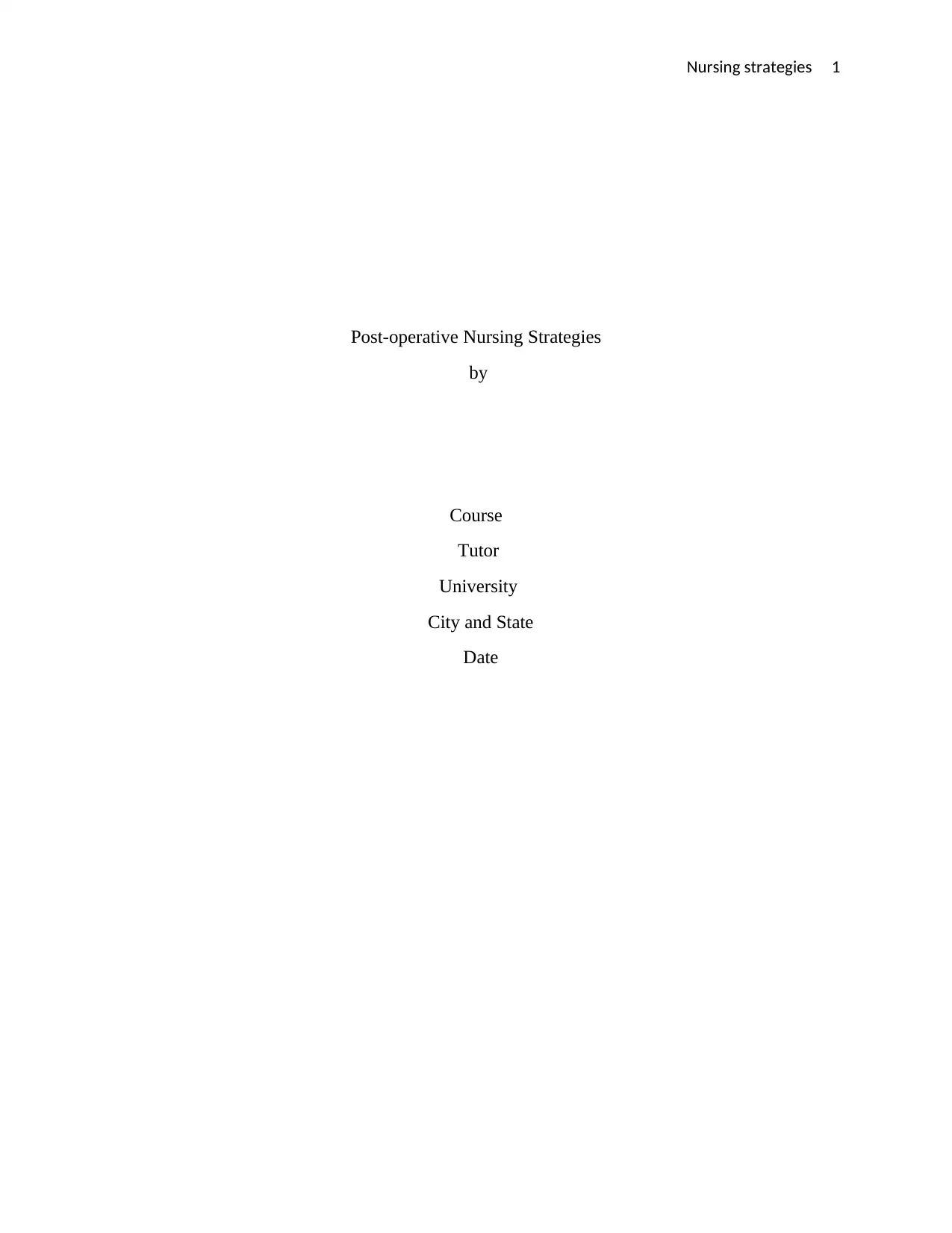
Nursing strategies 1
Post-operative Nursing Strategies
by
Course
Tutor
University
City and State
Date
Post-operative Nursing Strategies
by
Course
Tutor
University
City and State
Date
Paraphrase This Document
Need a fresh take? Get an instant paraphrase of this document with our AI Paraphraser
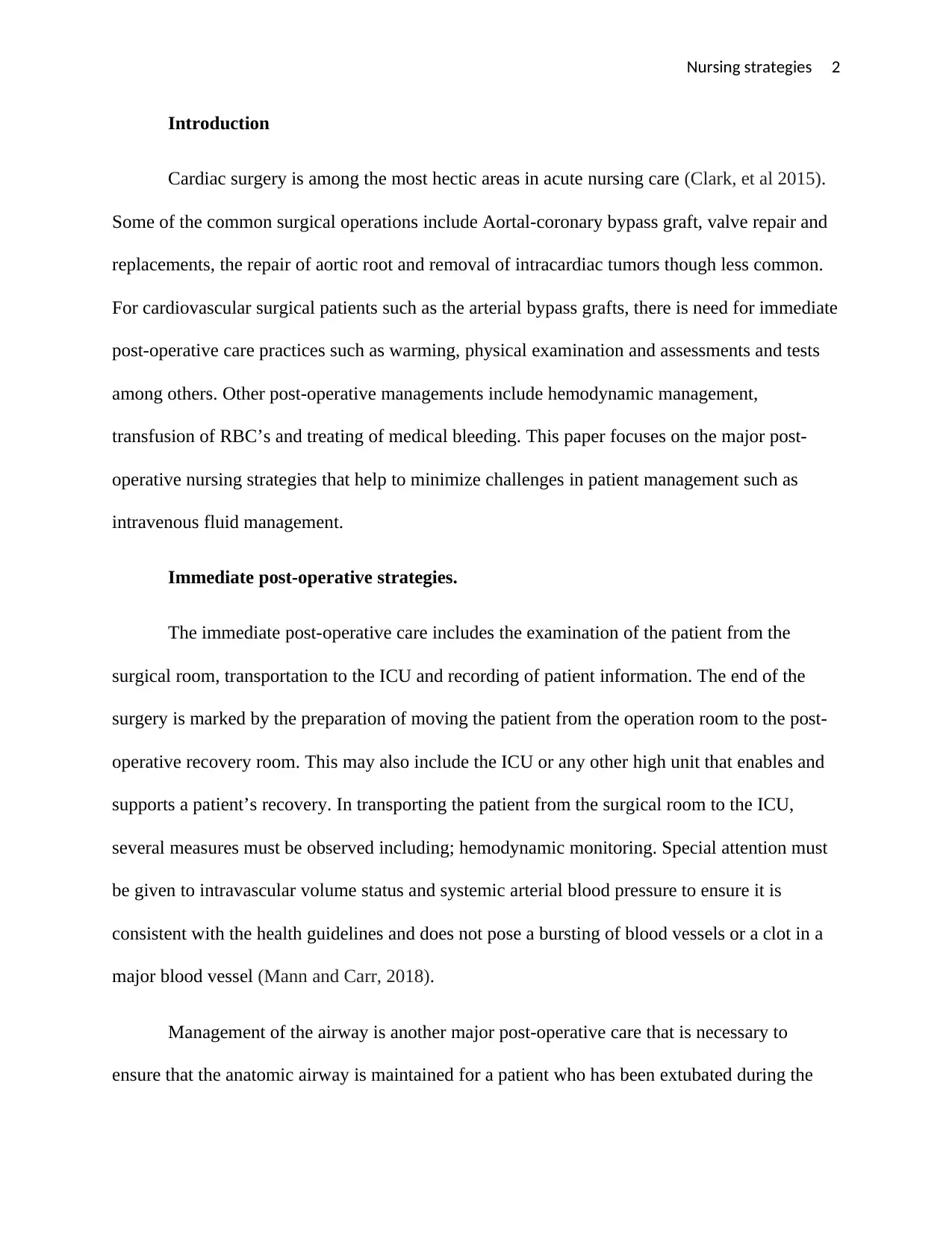
Nursing strategies 2
Introduction
Cardiac surgery is among the most hectic areas in acute nursing care (Clark, et al 2015).
Some of the common surgical operations include Aortal-coronary bypass graft, valve repair and
replacements, the repair of aortic root and removal of intracardiac tumors though less common.
For cardiovascular surgical patients such as the arterial bypass grafts, there is need for immediate
post-operative care practices such as warming, physical examination and assessments and tests
among others. Other post-operative managements include hemodynamic management,
transfusion of RBC’s and treating of medical bleeding. This paper focuses on the major post-
operative nursing strategies that help to minimize challenges in patient management such as
intravenous fluid management.
Immediate post-operative strategies.
The immediate post-operative care includes the examination of the patient from the
surgical room, transportation to the ICU and recording of patient information. The end of the
surgery is marked by the preparation of moving the patient from the operation room to the post-
operative recovery room. This may also include the ICU or any other high unit that enables and
supports a patient’s recovery. In transporting the patient from the surgical room to the ICU,
several measures must be observed including; hemodynamic monitoring. Special attention must
be given to intravascular volume status and systemic arterial blood pressure to ensure it is
consistent with the health guidelines and does not pose a bursting of blood vessels or a clot in a
major blood vessel (Mann and Carr, 2018).
Management of the airway is another major post-operative care that is necessary to
ensure that the anatomic airway is maintained for a patient who has been extubated during the
Introduction
Cardiac surgery is among the most hectic areas in acute nursing care (Clark, et al 2015).
Some of the common surgical operations include Aortal-coronary bypass graft, valve repair and
replacements, the repair of aortic root and removal of intracardiac tumors though less common.
For cardiovascular surgical patients such as the arterial bypass grafts, there is need for immediate
post-operative care practices such as warming, physical examination and assessments and tests
among others. Other post-operative managements include hemodynamic management,
transfusion of RBC’s and treating of medical bleeding. This paper focuses on the major post-
operative nursing strategies that help to minimize challenges in patient management such as
intravenous fluid management.
Immediate post-operative strategies.
The immediate post-operative care includes the examination of the patient from the
surgical room, transportation to the ICU and recording of patient information. The end of the
surgery is marked by the preparation of moving the patient from the operation room to the post-
operative recovery room. This may also include the ICU or any other high unit that enables and
supports a patient’s recovery. In transporting the patient from the surgical room to the ICU,
several measures must be observed including; hemodynamic monitoring. Special attention must
be given to intravascular volume status and systemic arterial blood pressure to ensure it is
consistent with the health guidelines and does not pose a bursting of blood vessels or a clot in a
major blood vessel (Mann and Carr, 2018).
Management of the airway is another major post-operative care that is necessary to
ensure that the anatomic airway is maintained for a patient who has been extubated during the
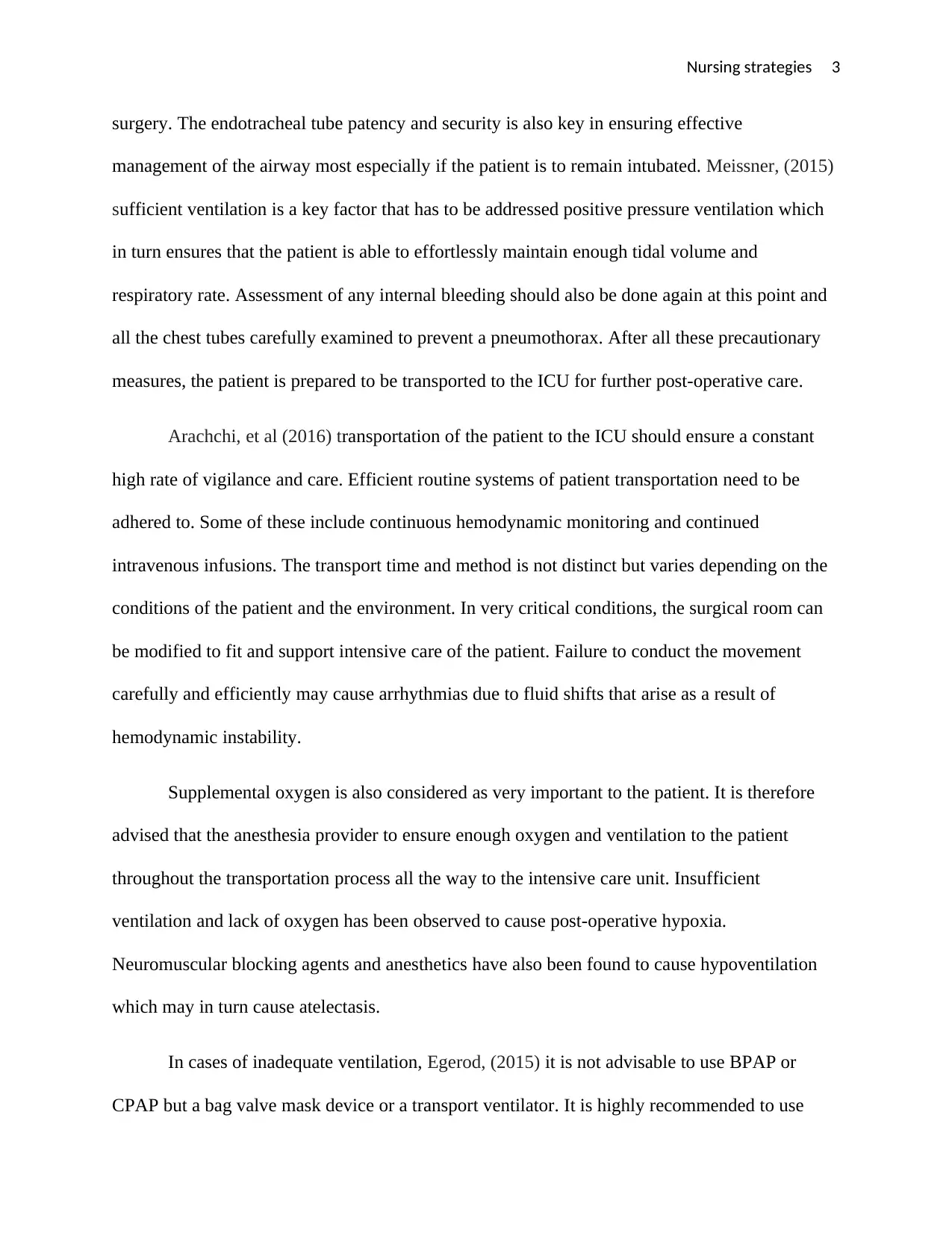
Nursing strategies 3
surgery. The endotracheal tube patency and security is also key in ensuring effective
management of the airway most especially if the patient is to remain intubated. Meissner, (2015)
sufficient ventilation is a key factor that has to be addressed positive pressure ventilation which
in turn ensures that the patient is able to effortlessly maintain enough tidal volume and
respiratory rate. Assessment of any internal bleeding should also be done again at this point and
all the chest tubes carefully examined to prevent a pneumothorax. After all these precautionary
measures, the patient is prepared to be transported to the ICU for further post-operative care.
Arachchi, et al (2016) transportation of the patient to the ICU should ensure a constant
high rate of vigilance and care. Efficient routine systems of patient transportation need to be
adhered to. Some of these include continuous hemodynamic monitoring and continued
intravenous infusions. The transport time and method is not distinct but varies depending on the
conditions of the patient and the environment. In very critical conditions, the surgical room can
be modified to fit and support intensive care of the patient. Failure to conduct the movement
carefully and efficiently may cause arrhythmias due to fluid shifts that arise as a result of
hemodynamic instability.
Supplemental oxygen is also considered as very important to the patient. It is therefore
advised that the anesthesia provider to ensure enough oxygen and ventilation to the patient
throughout the transportation process all the way to the intensive care unit. Insufficient
ventilation and lack of oxygen has been observed to cause post-operative hypoxia.
Neuromuscular blocking agents and anesthetics have also been found to cause hypoventilation
which may in turn cause atelectasis.
In cases of inadequate ventilation, Egerod, (2015) it is not advisable to use BPAP or
CPAP but a bag valve mask device or a transport ventilator. It is highly recommended to use
surgery. The endotracheal tube patency and security is also key in ensuring effective
management of the airway most especially if the patient is to remain intubated. Meissner, (2015)
sufficient ventilation is a key factor that has to be addressed positive pressure ventilation which
in turn ensures that the patient is able to effortlessly maintain enough tidal volume and
respiratory rate. Assessment of any internal bleeding should also be done again at this point and
all the chest tubes carefully examined to prevent a pneumothorax. After all these precautionary
measures, the patient is prepared to be transported to the ICU for further post-operative care.
Arachchi, et al (2016) transportation of the patient to the ICU should ensure a constant
high rate of vigilance and care. Efficient routine systems of patient transportation need to be
adhered to. Some of these include continuous hemodynamic monitoring and continued
intravenous infusions. The transport time and method is not distinct but varies depending on the
conditions of the patient and the environment. In very critical conditions, the surgical room can
be modified to fit and support intensive care of the patient. Failure to conduct the movement
carefully and efficiently may cause arrhythmias due to fluid shifts that arise as a result of
hemodynamic instability.
Supplemental oxygen is also considered as very important to the patient. It is therefore
advised that the anesthesia provider to ensure enough oxygen and ventilation to the patient
throughout the transportation process all the way to the intensive care unit. Insufficient
ventilation and lack of oxygen has been observed to cause post-operative hypoxia.
Neuromuscular blocking agents and anesthetics have also been found to cause hypoventilation
which may in turn cause atelectasis.
In cases of inadequate ventilation, Egerod, (2015) it is not advisable to use BPAP or
CPAP but a bag valve mask device or a transport ventilator. It is highly recommended to use
⊘ This is a preview!⊘
Do you want full access?
Subscribe today to unlock all pages.

Trusted by 1+ million students worldwide
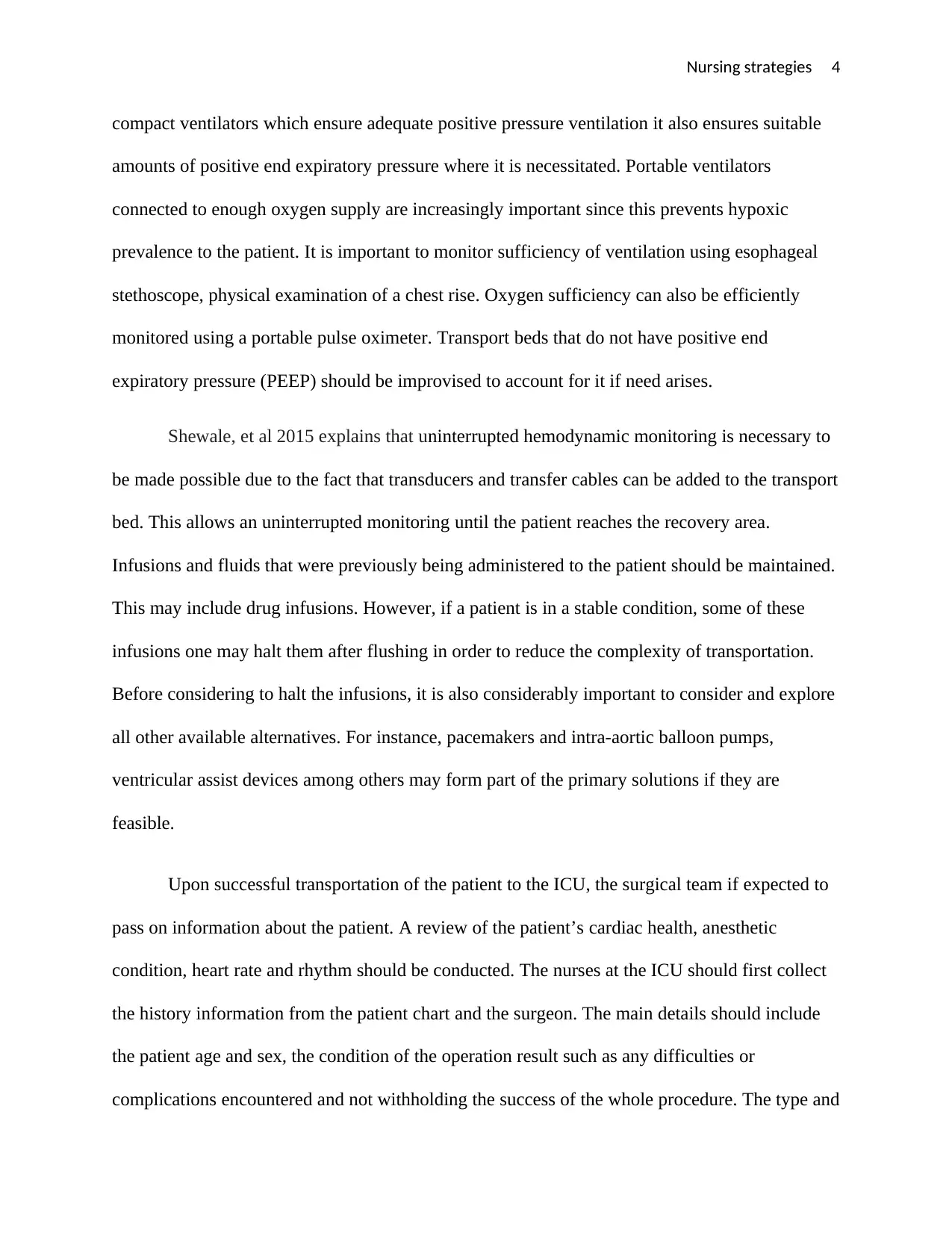
Nursing strategies 4
compact ventilators which ensure adequate positive pressure ventilation it also ensures suitable
amounts of positive end expiratory pressure where it is necessitated. Portable ventilators
connected to enough oxygen supply are increasingly important since this prevents hypoxic
prevalence to the patient. It is important to monitor sufficiency of ventilation using esophageal
stethoscope, physical examination of a chest rise. Oxygen sufficiency can also be efficiently
monitored using a portable pulse oximeter. Transport beds that do not have positive end
expiratory pressure (PEEP) should be improvised to account for it if need arises.
Shewale, et al 2015 explains that uninterrupted hemodynamic monitoring is necessary to
be made possible due to the fact that transducers and transfer cables can be added to the transport
bed. This allows an uninterrupted monitoring until the patient reaches the recovery area.
Infusions and fluids that were previously being administered to the patient should be maintained.
This may include drug infusions. However, if a patient is in a stable condition, some of these
infusions one may halt them after flushing in order to reduce the complexity of transportation.
Before considering to halt the infusions, it is also considerably important to consider and explore
all other available alternatives. For instance, pacemakers and intra-aortic balloon pumps,
ventricular assist devices among others may form part of the primary solutions if they are
feasible.
Upon successful transportation of the patient to the ICU, the surgical team if expected to
pass on information about the patient. A review of the patient’s cardiac health, anesthetic
condition, heart rate and rhythm should be conducted. The nurses at the ICU should first collect
the history information from the patient chart and the surgeon. The main details should include
the patient age and sex, the condition of the operation result such as any difficulties or
complications encountered and not withholding the success of the whole procedure. The type and
compact ventilators which ensure adequate positive pressure ventilation it also ensures suitable
amounts of positive end expiratory pressure where it is necessitated. Portable ventilators
connected to enough oxygen supply are increasingly important since this prevents hypoxic
prevalence to the patient. It is important to monitor sufficiency of ventilation using esophageal
stethoscope, physical examination of a chest rise. Oxygen sufficiency can also be efficiently
monitored using a portable pulse oximeter. Transport beds that do not have positive end
expiratory pressure (PEEP) should be improvised to account for it if need arises.
Shewale, et al 2015 explains that uninterrupted hemodynamic monitoring is necessary to
be made possible due to the fact that transducers and transfer cables can be added to the transport
bed. This allows an uninterrupted monitoring until the patient reaches the recovery area.
Infusions and fluids that were previously being administered to the patient should be maintained.
This may include drug infusions. However, if a patient is in a stable condition, some of these
infusions one may halt them after flushing in order to reduce the complexity of transportation.
Before considering to halt the infusions, it is also considerably important to consider and explore
all other available alternatives. For instance, pacemakers and intra-aortic balloon pumps,
ventricular assist devices among others may form part of the primary solutions if they are
feasible.
Upon successful transportation of the patient to the ICU, the surgical team if expected to
pass on information about the patient. A review of the patient’s cardiac health, anesthetic
condition, heart rate and rhythm should be conducted. The nurses at the ICU should first collect
the history information from the patient chart and the surgeon. The main details should include
the patient age and sex, the condition of the operation result such as any difficulties or
complications encountered and not withholding the success of the whole procedure. The type and
Paraphrase This Document
Need a fresh take? Get an instant paraphrase of this document with our AI Paraphraser
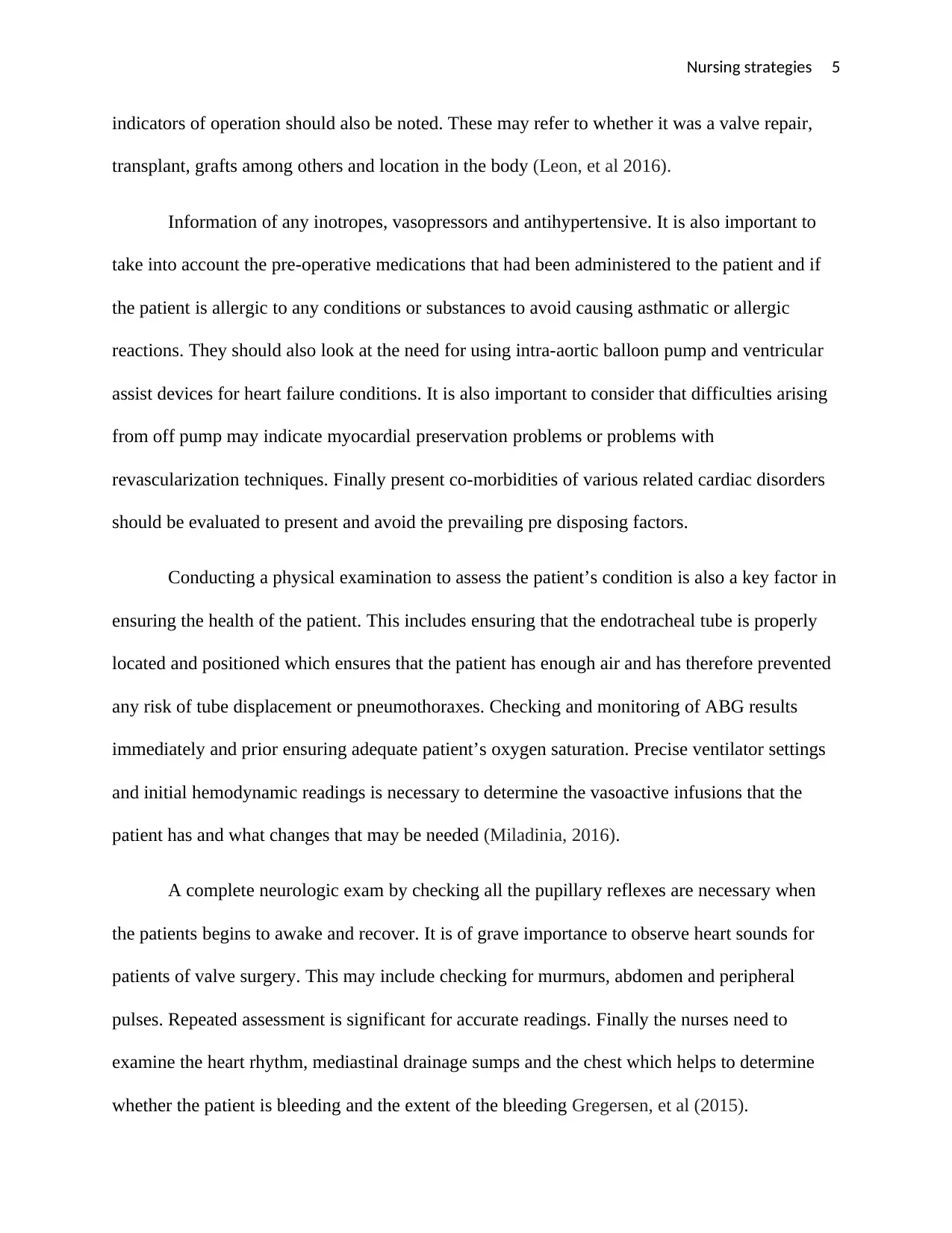
Nursing strategies 5
indicators of operation should also be noted. These may refer to whether it was a valve repair,
transplant, grafts among others and location in the body (Leon, et al 2016).
Information of any inotropes, vasopressors and antihypertensive. It is also important to
take into account the pre-operative medications that had been administered to the patient and if
the patient is allergic to any conditions or substances to avoid causing asthmatic or allergic
reactions. They should also look at the need for using intra-aortic balloon pump and ventricular
assist devices for heart failure conditions. It is also important to consider that difficulties arising
from off pump may indicate myocardial preservation problems or problems with
revascularization techniques. Finally present co-morbidities of various related cardiac disorders
should be evaluated to present and avoid the prevailing pre disposing factors.
Conducting a physical examination to assess the patient’s condition is also a key factor in
ensuring the health of the patient. This includes ensuring that the endotracheal tube is properly
located and positioned which ensures that the patient has enough air and has therefore prevented
any risk of tube displacement or pneumothoraxes. Checking and monitoring of ABG results
immediately and prior ensuring adequate patient’s oxygen saturation. Precise ventilator settings
and initial hemodynamic readings is necessary to determine the vasoactive infusions that the
patient has and what changes that may be needed (Miladinia, 2016).
A complete neurologic exam by checking all the pupillary reflexes are necessary when
the patients begins to awake and recover. It is of grave importance to observe heart sounds for
patients of valve surgery. This may include checking for murmurs, abdomen and peripheral
pulses. Repeated assessment is significant for accurate readings. Finally the nurses need to
examine the heart rhythm, mediastinal drainage sumps and the chest which helps to determine
whether the patient is bleeding and the extent of the bleeding Gregersen, et al (2015).
indicators of operation should also be noted. These may refer to whether it was a valve repair,
transplant, grafts among others and location in the body (Leon, et al 2016).
Information of any inotropes, vasopressors and antihypertensive. It is also important to
take into account the pre-operative medications that had been administered to the patient and if
the patient is allergic to any conditions or substances to avoid causing asthmatic or allergic
reactions. They should also look at the need for using intra-aortic balloon pump and ventricular
assist devices for heart failure conditions. It is also important to consider that difficulties arising
from off pump may indicate myocardial preservation problems or problems with
revascularization techniques. Finally present co-morbidities of various related cardiac disorders
should be evaluated to present and avoid the prevailing pre disposing factors.
Conducting a physical examination to assess the patient’s condition is also a key factor in
ensuring the health of the patient. This includes ensuring that the endotracheal tube is properly
located and positioned which ensures that the patient has enough air and has therefore prevented
any risk of tube displacement or pneumothoraxes. Checking and monitoring of ABG results
immediately and prior ensuring adequate patient’s oxygen saturation. Precise ventilator settings
and initial hemodynamic readings is necessary to determine the vasoactive infusions that the
patient has and what changes that may be needed (Miladinia, 2016).
A complete neurologic exam by checking all the pupillary reflexes are necessary when
the patients begins to awake and recover. It is of grave importance to observe heart sounds for
patients of valve surgery. This may include checking for murmurs, abdomen and peripheral
pulses. Repeated assessment is significant for accurate readings. Finally the nurses need to
examine the heart rhythm, mediastinal drainage sumps and the chest which helps to determine
whether the patient is bleeding and the extent of the bleeding Gregersen, et al (2015).
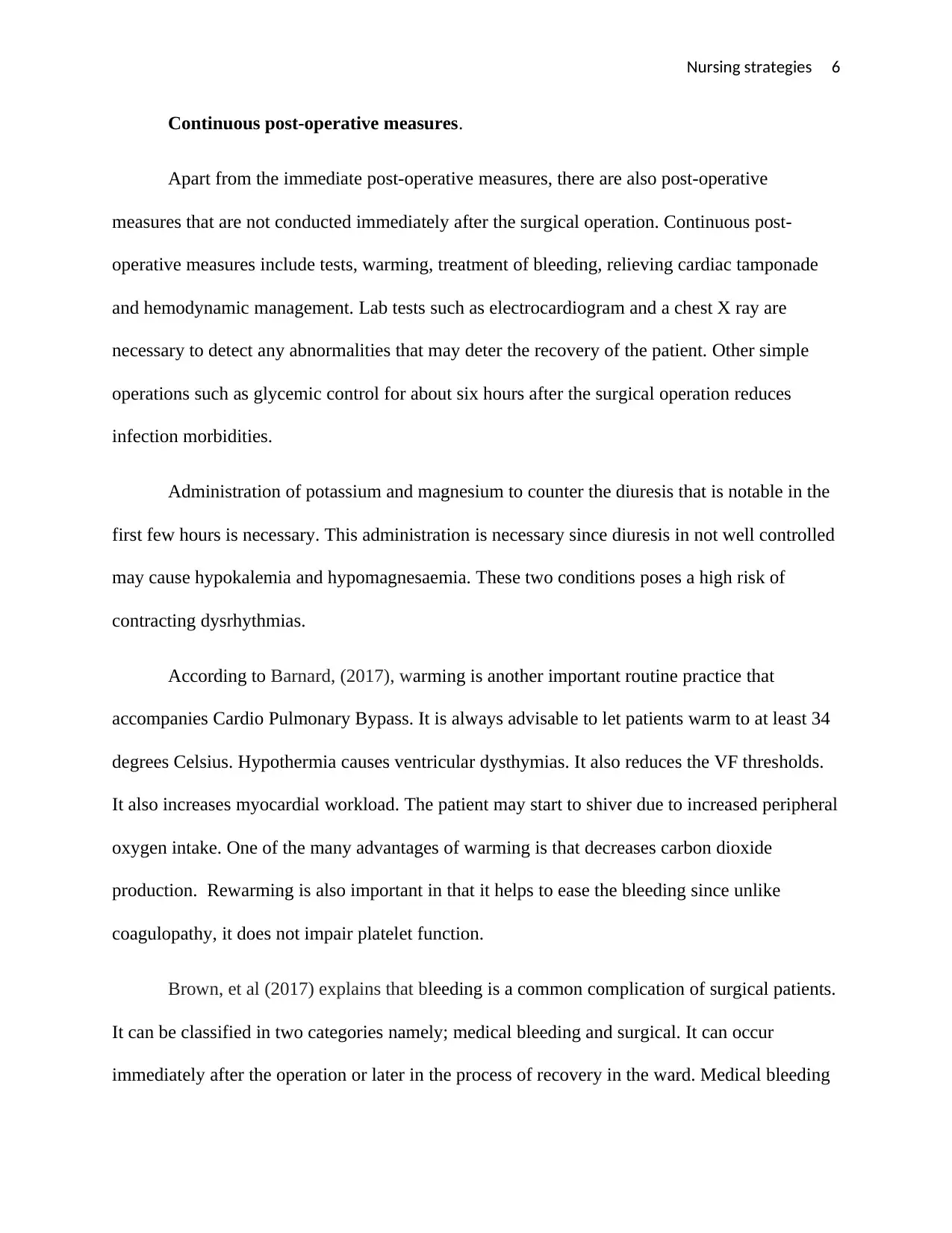
Nursing strategies 6
Continuous post-operative measures.
Apart from the immediate post-operative measures, there are also post-operative
measures that are not conducted immediately after the surgical operation. Continuous post-
operative measures include tests, warming, treatment of bleeding, relieving cardiac tamponade
and hemodynamic management. Lab tests such as electrocardiogram and a chest X ray are
necessary to detect any abnormalities that may deter the recovery of the patient. Other simple
operations such as glycemic control for about six hours after the surgical operation reduces
infection morbidities.
Administration of potassium and magnesium to counter the diuresis that is notable in the
first few hours is necessary. This administration is necessary since diuresis in not well controlled
may cause hypokalemia and hypomagnesaemia. These two conditions poses a high risk of
contracting dysrhythmias.
According to Barnard, (2017), warming is another important routine practice that
accompanies Cardio Pulmonary Bypass. It is always advisable to let patients warm to at least 34
degrees Celsius. Hypothermia causes ventricular dysthymias. It also reduces the VF thresholds.
It also increases myocardial workload. The patient may start to shiver due to increased peripheral
oxygen intake. One of the many advantages of warming is that decreases carbon dioxide
production. Rewarming is also important in that it helps to ease the bleeding since unlike
coagulopathy, it does not impair platelet function.
Brown, et al (2017) explains that bleeding is a common complication of surgical patients.
It can be classified in two categories namely; medical bleeding and surgical. It can occur
immediately after the operation or later in the process of recovery in the ward. Medical bleeding
Continuous post-operative measures.
Apart from the immediate post-operative measures, there are also post-operative
measures that are not conducted immediately after the surgical operation. Continuous post-
operative measures include tests, warming, treatment of bleeding, relieving cardiac tamponade
and hemodynamic management. Lab tests such as electrocardiogram and a chest X ray are
necessary to detect any abnormalities that may deter the recovery of the patient. Other simple
operations such as glycemic control for about six hours after the surgical operation reduces
infection morbidities.
Administration of potassium and magnesium to counter the diuresis that is notable in the
first few hours is necessary. This administration is necessary since diuresis in not well controlled
may cause hypokalemia and hypomagnesaemia. These two conditions poses a high risk of
contracting dysrhythmias.
According to Barnard, (2017), warming is another important routine practice that
accompanies Cardio Pulmonary Bypass. It is always advisable to let patients warm to at least 34
degrees Celsius. Hypothermia causes ventricular dysthymias. It also reduces the VF thresholds.
It also increases myocardial workload. The patient may start to shiver due to increased peripheral
oxygen intake. One of the many advantages of warming is that decreases carbon dioxide
production. Rewarming is also important in that it helps to ease the bleeding since unlike
coagulopathy, it does not impair platelet function.
Brown, et al (2017) explains that bleeding is a common complication of surgical patients.
It can be classified in two categories namely; medical bleeding and surgical. It can occur
immediately after the operation or later in the process of recovery in the ward. Medical bleeding
⊘ This is a preview!⊘
Do you want full access?
Subscribe today to unlock all pages.

Trusted by 1+ million students worldwide
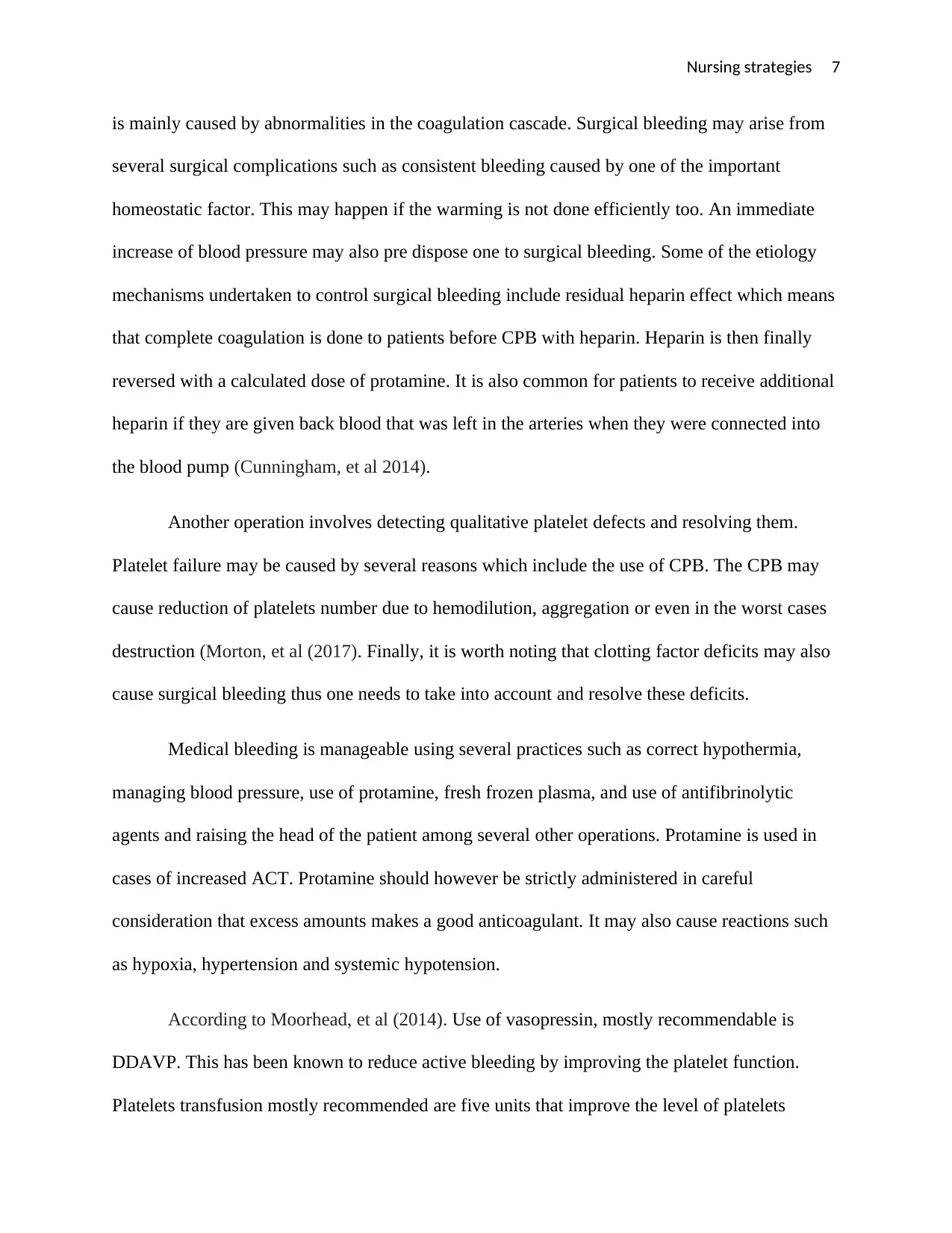
Nursing strategies 7
is mainly caused by abnormalities in the coagulation cascade. Surgical bleeding may arise from
several surgical complications such as consistent bleeding caused by one of the important
homeostatic factor. This may happen if the warming is not done efficiently too. An immediate
increase of blood pressure may also pre dispose one to surgical bleeding. Some of the etiology
mechanisms undertaken to control surgical bleeding include residual heparin effect which means
that complete coagulation is done to patients before CPB with heparin. Heparin is then finally
reversed with a calculated dose of protamine. It is also common for patients to receive additional
heparin if they are given back blood that was left in the arteries when they were connected into
the blood pump (Cunningham, et al 2014).
Another operation involves detecting qualitative platelet defects and resolving them.
Platelet failure may be caused by several reasons which include the use of CPB. The CPB may
cause reduction of platelets number due to hemodilution, aggregation or even in the worst cases
destruction (Morton, et al (2017). Finally, it is worth noting that clotting factor deficits may also
cause surgical bleeding thus one needs to take into account and resolve these deficits.
Medical bleeding is manageable using several practices such as correct hypothermia,
managing blood pressure, use of protamine, fresh frozen plasma, and use of antifibrinolytic
agents and raising the head of the patient among several other operations. Protamine is used in
cases of increased ACT. Protamine should however be strictly administered in careful
consideration that excess amounts makes a good anticoagulant. It may also cause reactions such
as hypoxia, hypertension and systemic hypotension.
According to Moorhead, et al (2014). Use of vasopressin, mostly recommendable is
DDAVP. This has been known to reduce active bleeding by improving the platelet function.
Platelets transfusion mostly recommended are five units that improve the level of platelets
is mainly caused by abnormalities in the coagulation cascade. Surgical bleeding may arise from
several surgical complications such as consistent bleeding caused by one of the important
homeostatic factor. This may happen if the warming is not done efficiently too. An immediate
increase of blood pressure may also pre dispose one to surgical bleeding. Some of the etiology
mechanisms undertaken to control surgical bleeding include residual heparin effect which means
that complete coagulation is done to patients before CPB with heparin. Heparin is then finally
reversed with a calculated dose of protamine. It is also common for patients to receive additional
heparin if they are given back blood that was left in the arteries when they were connected into
the blood pump (Cunningham, et al 2014).
Another operation involves detecting qualitative platelet defects and resolving them.
Platelet failure may be caused by several reasons which include the use of CPB. The CPB may
cause reduction of platelets number due to hemodilution, aggregation or even in the worst cases
destruction (Morton, et al (2017). Finally, it is worth noting that clotting factor deficits may also
cause surgical bleeding thus one needs to take into account and resolve these deficits.
Medical bleeding is manageable using several practices such as correct hypothermia,
managing blood pressure, use of protamine, fresh frozen plasma, and use of antifibrinolytic
agents and raising the head of the patient among several other operations. Protamine is used in
cases of increased ACT. Protamine should however be strictly administered in careful
consideration that excess amounts makes a good anticoagulant. It may also cause reactions such
as hypoxia, hypertension and systemic hypotension.
According to Moorhead, et al (2014). Use of vasopressin, mostly recommendable is
DDAVP. This has been known to reduce active bleeding by improving the platelet function.
Platelets transfusion mostly recommended are five units that improve the level of platelets
Paraphrase This Document
Need a fresh take? Get an instant paraphrase of this document with our AI Paraphraser
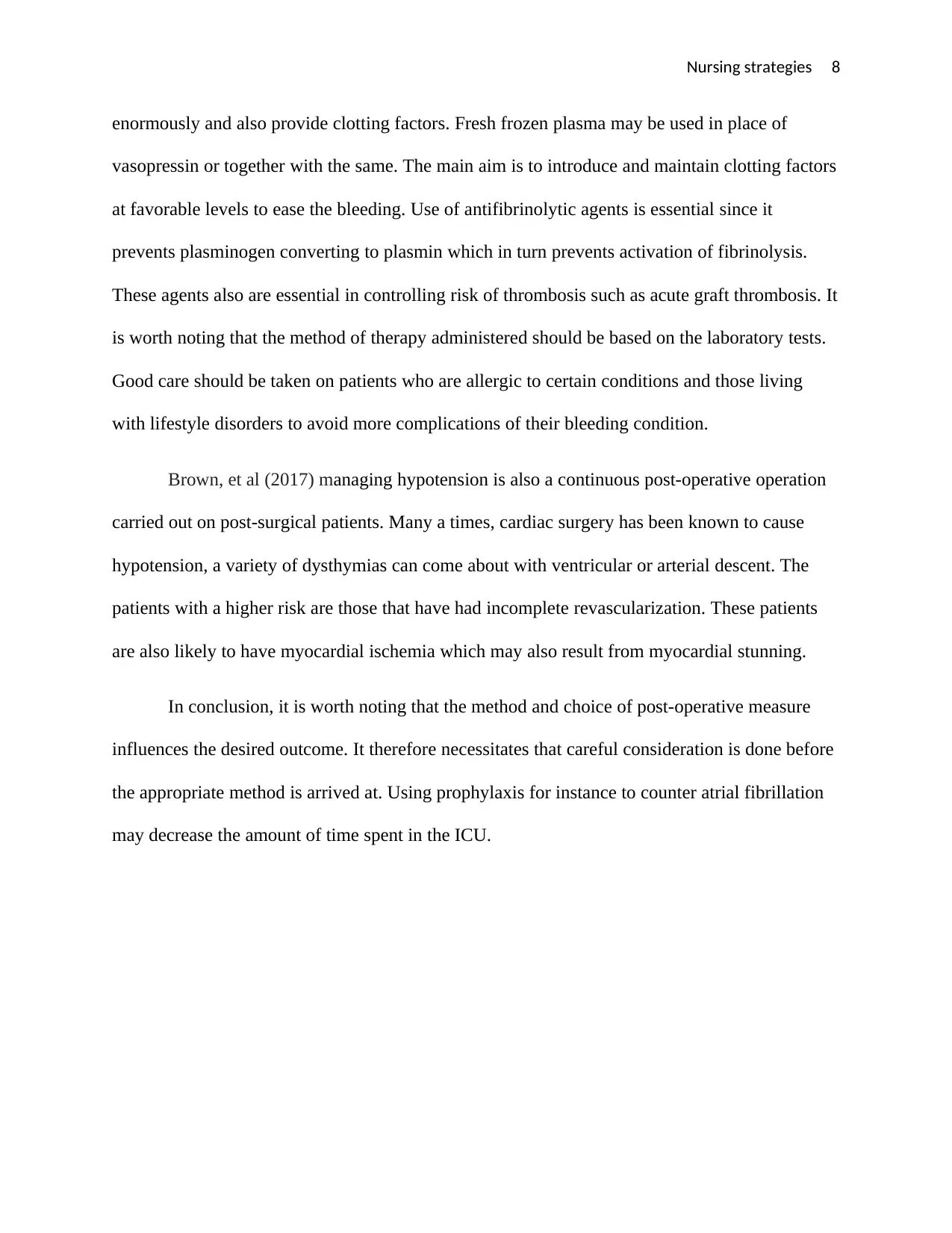
Nursing strategies 8
enormously and also provide clotting factors. Fresh frozen plasma may be used in place of
vasopressin or together with the same. The main aim is to introduce and maintain clotting factors
at favorable levels to ease the bleeding. Use of antifibrinolytic agents is essential since it
prevents plasminogen converting to plasmin which in turn prevents activation of fibrinolysis.
These agents also are essential in controlling risk of thrombosis such as acute graft thrombosis. It
is worth noting that the method of therapy administered should be based on the laboratory tests.
Good care should be taken on patients who are allergic to certain conditions and those living
with lifestyle disorders to avoid more complications of their bleeding condition.
Brown, et al (2017) managing hypotension is also a continuous post-operative operation
carried out on post-surgical patients. Many a times, cardiac surgery has been known to cause
hypotension, a variety of dysthymias can come about with ventricular or arterial descent. The
patients with a higher risk are those that have had incomplete revascularization. These patients
are also likely to have myocardial ischemia which may also result from myocardial stunning.
In conclusion, it is worth noting that the method and choice of post-operative measure
influences the desired outcome. It therefore necessitates that careful consideration is done before
the appropriate method is arrived at. Using prophylaxis for instance to counter atrial fibrillation
may decrease the amount of time spent in the ICU.
enormously and also provide clotting factors. Fresh frozen plasma may be used in place of
vasopressin or together with the same. The main aim is to introduce and maintain clotting factors
at favorable levels to ease the bleeding. Use of antifibrinolytic agents is essential since it
prevents plasminogen converting to plasmin which in turn prevents activation of fibrinolysis.
These agents also are essential in controlling risk of thrombosis such as acute graft thrombosis. It
is worth noting that the method of therapy administered should be based on the laboratory tests.
Good care should be taken on patients who are allergic to certain conditions and those living
with lifestyle disorders to avoid more complications of their bleeding condition.
Brown, et al (2017) managing hypotension is also a continuous post-operative operation
carried out on post-surgical patients. Many a times, cardiac surgery has been known to cause
hypotension, a variety of dysthymias can come about with ventricular or arterial descent. The
patients with a higher risk are those that have had incomplete revascularization. These patients
are also likely to have myocardial ischemia which may also result from myocardial stunning.
In conclusion, it is worth noting that the method and choice of post-operative measure
influences the desired outcome. It therefore necessitates that careful consideration is done before
the appropriate method is arrived at. Using prophylaxis for instance to counter atrial fibrillation
may decrease the amount of time spent in the ICU.
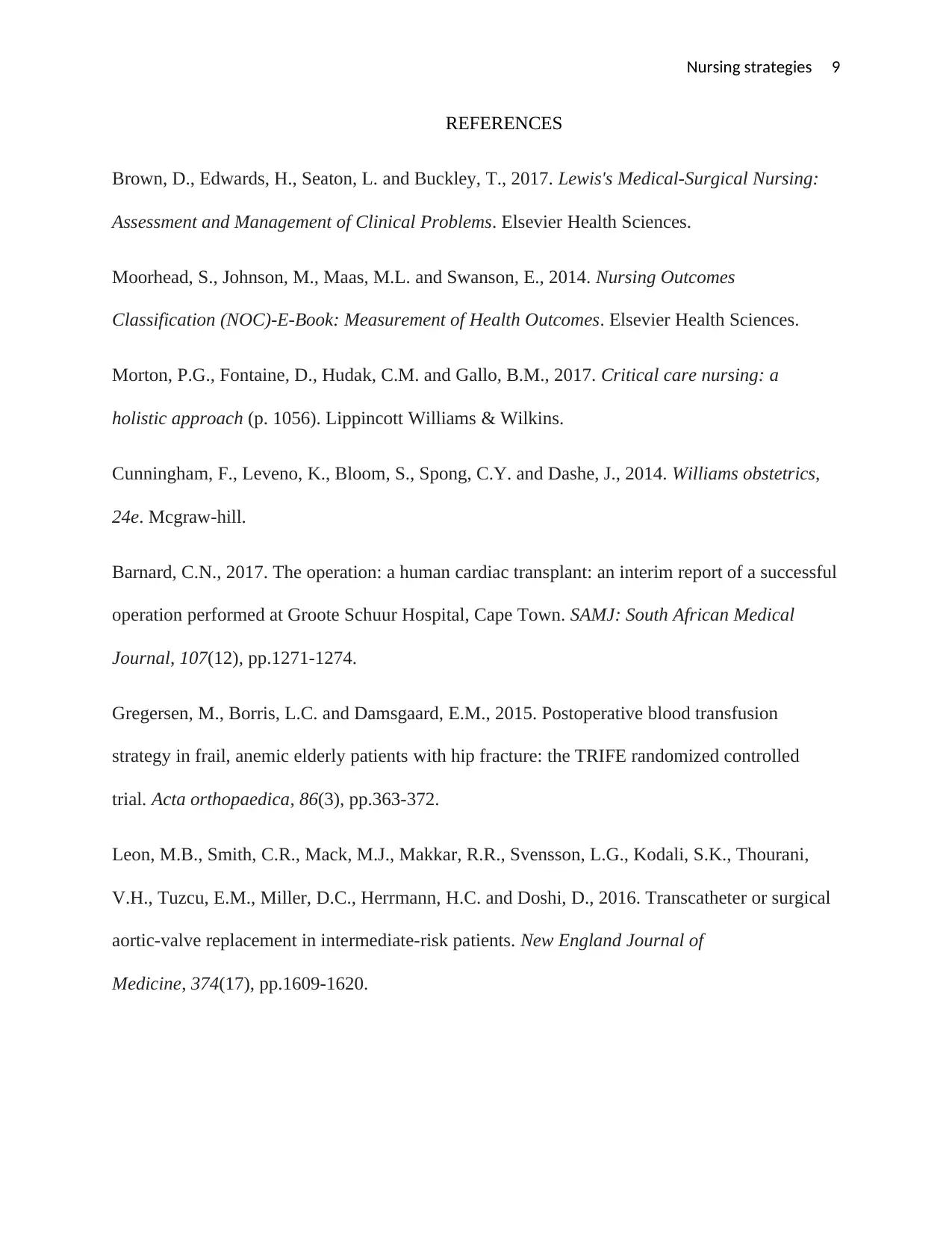
Nursing strategies 9
REFERENCES
Brown, D., Edwards, H., Seaton, L. and Buckley, T., 2017. Lewis's Medical-Surgical Nursing:
Assessment and Management of Clinical Problems. Elsevier Health Sciences.
Moorhead, S., Johnson, M., Maas, M.L. and Swanson, E., 2014. Nursing Outcomes
Classification (NOC)-E-Book: Measurement of Health Outcomes. Elsevier Health Sciences.
Morton, P.G., Fontaine, D., Hudak, C.M. and Gallo, B.M., 2017. Critical care nursing: a
holistic approach (p. 1056). Lippincott Williams & Wilkins.
Cunningham, F., Leveno, K., Bloom, S., Spong, C.Y. and Dashe, J., 2014. Williams obstetrics,
24e. Mcgraw-hill.
Barnard, C.N., 2017. The operation: a human cardiac transplant: an interim report of a successful
operation performed at Groote Schuur Hospital, Cape Town. SAMJ: South African Medical
Journal, 107(12), pp.1271-1274.
Gregersen, M., Borris, L.C. and Damsgaard, E.M., 2015. Postoperative blood transfusion
strategy in frail, anemic elderly patients with hip fracture: the TRIFE randomized controlled
trial. Acta orthopaedica, 86(3), pp.363-372.
Leon, M.B., Smith, C.R., Mack, M.J., Makkar, R.R., Svensson, L.G., Kodali, S.K., Thourani,
V.H., Tuzcu, E.M., Miller, D.C., Herrmann, H.C. and Doshi, D., 2016. Transcatheter or surgical
aortic-valve replacement in intermediate-risk patients. New England Journal of
Medicine, 374(17), pp.1609-1620.
REFERENCES
Brown, D., Edwards, H., Seaton, L. and Buckley, T., 2017. Lewis's Medical-Surgical Nursing:
Assessment and Management of Clinical Problems. Elsevier Health Sciences.
Moorhead, S., Johnson, M., Maas, M.L. and Swanson, E., 2014. Nursing Outcomes
Classification (NOC)-E-Book: Measurement of Health Outcomes. Elsevier Health Sciences.
Morton, P.G., Fontaine, D., Hudak, C.M. and Gallo, B.M., 2017. Critical care nursing: a
holistic approach (p. 1056). Lippincott Williams & Wilkins.
Cunningham, F., Leveno, K., Bloom, S., Spong, C.Y. and Dashe, J., 2014. Williams obstetrics,
24e. Mcgraw-hill.
Barnard, C.N., 2017. The operation: a human cardiac transplant: an interim report of a successful
operation performed at Groote Schuur Hospital, Cape Town. SAMJ: South African Medical
Journal, 107(12), pp.1271-1274.
Gregersen, M., Borris, L.C. and Damsgaard, E.M., 2015. Postoperative blood transfusion
strategy in frail, anemic elderly patients with hip fracture: the TRIFE randomized controlled
trial. Acta orthopaedica, 86(3), pp.363-372.
Leon, M.B., Smith, C.R., Mack, M.J., Makkar, R.R., Svensson, L.G., Kodali, S.K., Thourani,
V.H., Tuzcu, E.M., Miller, D.C., Herrmann, H.C. and Doshi, D., 2016. Transcatheter or surgical
aortic-valve replacement in intermediate-risk patients. New England Journal of
Medicine, 374(17), pp.1609-1620.
⊘ This is a preview!⊘
Do you want full access?
Subscribe today to unlock all pages.

Trusted by 1+ million students worldwide
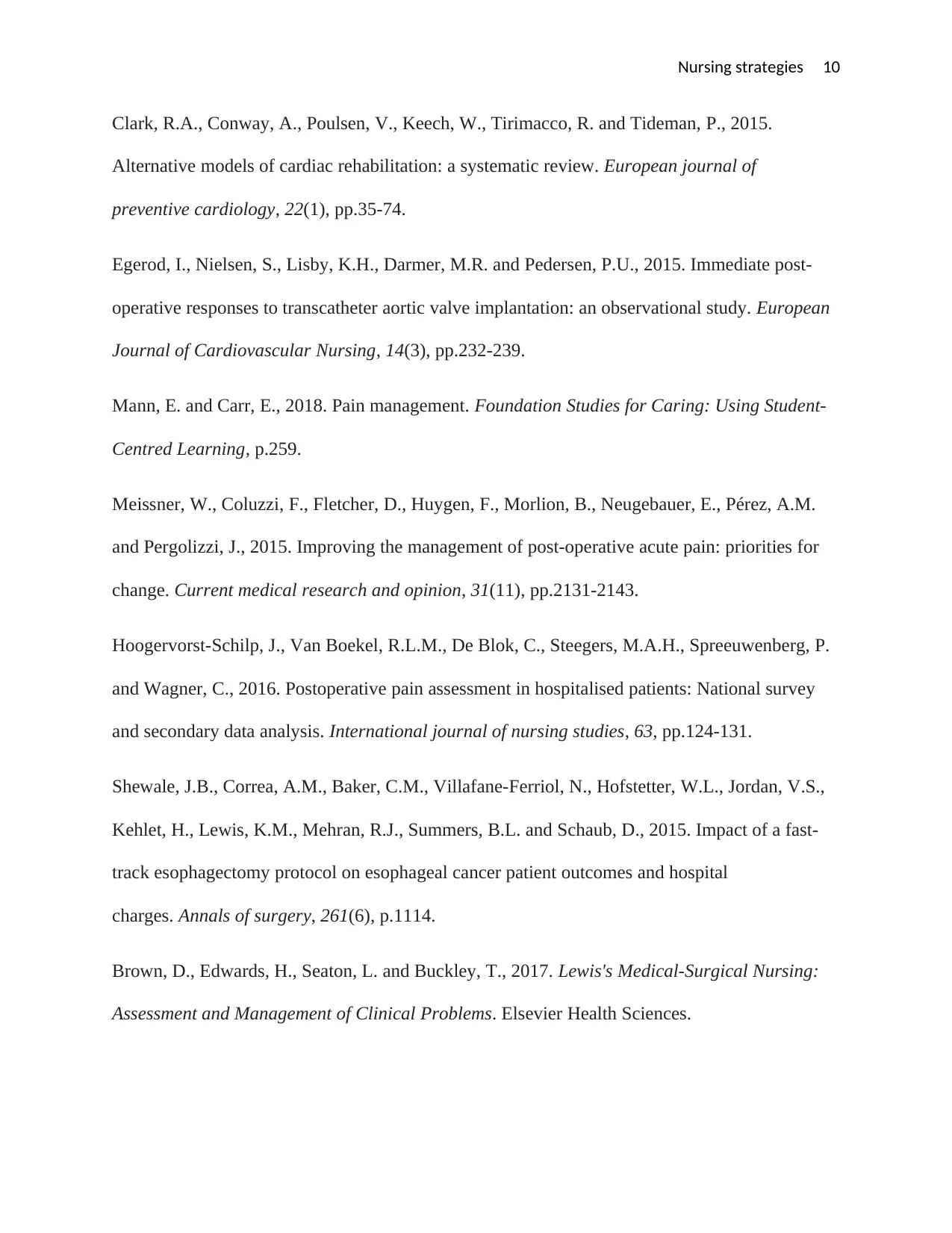
Nursing strategies 10
Clark, R.A., Conway, A., Poulsen, V., Keech, W., Tirimacco, R. and Tideman, P., 2015.
Alternative models of cardiac rehabilitation: a systematic review. European journal of
preventive cardiology, 22(1), pp.35-74.
Egerod, I., Nielsen, S., Lisby, K.H., Darmer, M.R. and Pedersen, P.U., 2015. Immediate post-
operative responses to transcatheter aortic valve implantation: an observational study. European
Journal of Cardiovascular Nursing, 14(3), pp.232-239.
Mann, E. and Carr, E., 2018. Pain management. Foundation Studies for Caring: Using Student-
Centred Learning, p.259.
Meissner, W., Coluzzi, F., Fletcher, D., Huygen, F., Morlion, B., Neugebauer, E., Pérez, A.M.
and Pergolizzi, J., 2015. Improving the management of post-operative acute pain: priorities for
change. Current medical research and opinion, 31(11), pp.2131-2143.
Hoogervorst-Schilp, J., Van Boekel, R.L.M., De Blok, C., Steegers, M.A.H., Spreeuwenberg, P.
and Wagner, C., 2016. Postoperative pain assessment in hospitalised patients: National survey
and secondary data analysis. International journal of nursing studies, 63, pp.124-131.
Shewale, J.B., Correa, A.M., Baker, C.M., Villafane-Ferriol, N., Hofstetter, W.L., Jordan, V.S.,
Kehlet, H., Lewis, K.M., Mehran, R.J., Summers, B.L. and Schaub, D., 2015. Impact of a fast-
track esophagectomy protocol on esophageal cancer patient outcomes and hospital
charges. Annals of surgery, 261(6), p.1114.
Brown, D., Edwards, H., Seaton, L. and Buckley, T., 2017. Lewis's Medical-Surgical Nursing:
Assessment and Management of Clinical Problems. Elsevier Health Sciences.
Clark, R.A., Conway, A., Poulsen, V., Keech, W., Tirimacco, R. and Tideman, P., 2015.
Alternative models of cardiac rehabilitation: a systematic review. European journal of
preventive cardiology, 22(1), pp.35-74.
Egerod, I., Nielsen, S., Lisby, K.H., Darmer, M.R. and Pedersen, P.U., 2015. Immediate post-
operative responses to transcatheter aortic valve implantation: an observational study. European
Journal of Cardiovascular Nursing, 14(3), pp.232-239.
Mann, E. and Carr, E., 2018. Pain management. Foundation Studies for Caring: Using Student-
Centred Learning, p.259.
Meissner, W., Coluzzi, F., Fletcher, D., Huygen, F., Morlion, B., Neugebauer, E., Pérez, A.M.
and Pergolizzi, J., 2015. Improving the management of post-operative acute pain: priorities for
change. Current medical research and opinion, 31(11), pp.2131-2143.
Hoogervorst-Schilp, J., Van Boekel, R.L.M., De Blok, C., Steegers, M.A.H., Spreeuwenberg, P.
and Wagner, C., 2016. Postoperative pain assessment in hospitalised patients: National survey
and secondary data analysis. International journal of nursing studies, 63, pp.124-131.
Shewale, J.B., Correa, A.M., Baker, C.M., Villafane-Ferriol, N., Hofstetter, W.L., Jordan, V.S.,
Kehlet, H., Lewis, K.M., Mehran, R.J., Summers, B.L. and Schaub, D., 2015. Impact of a fast-
track esophagectomy protocol on esophageal cancer patient outcomes and hospital
charges. Annals of surgery, 261(6), p.1114.
Brown, D., Edwards, H., Seaton, L. and Buckley, T., 2017. Lewis's Medical-Surgical Nursing:
Assessment and Management of Clinical Problems. Elsevier Health Sciences.
Paraphrase This Document
Need a fresh take? Get an instant paraphrase of this document with our AI Paraphraser
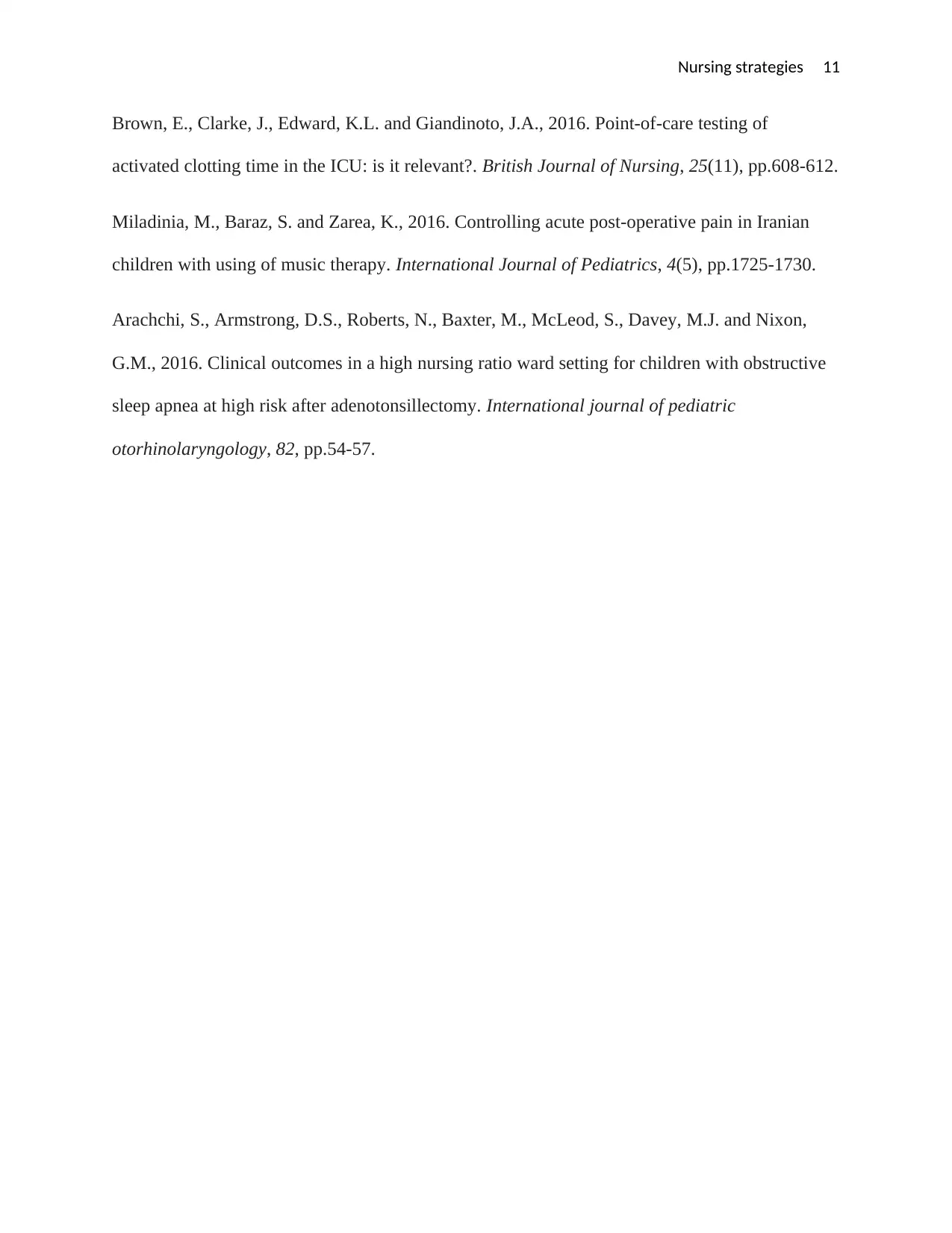
Nursing strategies 11
Brown, E., Clarke, J., Edward, K.L. and Giandinoto, J.A., 2016. Point-of-care testing of
activated clotting time in the ICU: is it relevant?. British Journal of Nursing, 25(11), pp.608-612.
Miladinia, M., Baraz, S. and Zarea, K., 2016. Controlling acute post-operative pain in Iranian
children with using of music therapy. International Journal of Pediatrics, 4(5), pp.1725-1730.
Arachchi, S., Armstrong, D.S., Roberts, N., Baxter, M., McLeod, S., Davey, M.J. and Nixon,
G.M., 2016. Clinical outcomes in a high nursing ratio ward setting for children with obstructive
sleep apnea at high risk after adenotonsillectomy. International journal of pediatric
otorhinolaryngology, 82, pp.54-57.
Brown, E., Clarke, J., Edward, K.L. and Giandinoto, J.A., 2016. Point-of-care testing of
activated clotting time in the ICU: is it relevant?. British Journal of Nursing, 25(11), pp.608-612.
Miladinia, M., Baraz, S. and Zarea, K., 2016. Controlling acute post-operative pain in Iranian
children with using of music therapy. International Journal of Pediatrics, 4(5), pp.1725-1730.
Arachchi, S., Armstrong, D.S., Roberts, N., Baxter, M., McLeod, S., Davey, M.J. and Nixon,
G.M., 2016. Clinical outcomes in a high nursing ratio ward setting for children with obstructive
sleep apnea at high risk after adenotonsillectomy. International journal of pediatric
otorhinolaryngology, 82, pp.54-57.
1 out of 11
Related Documents
Your All-in-One AI-Powered Toolkit for Academic Success.
+13062052269
info@desklib.com
Available 24*7 on WhatsApp / Email
![[object Object]](/_next/static/media/star-bottom.7253800d.svg)
Unlock your academic potential
Copyright © 2020–2025 A2Z Services. All Rights Reserved. Developed and managed by ZUCOL.





